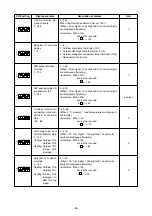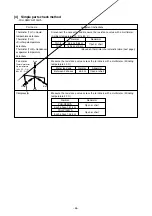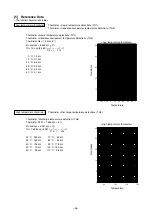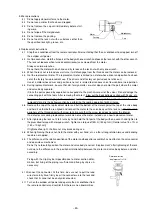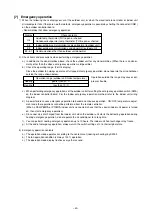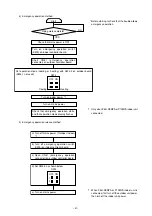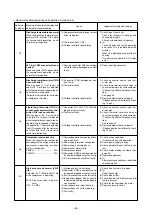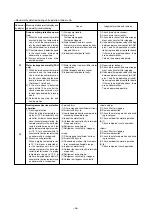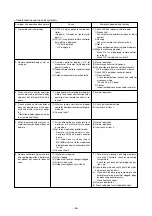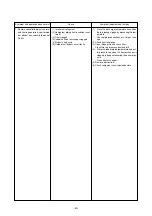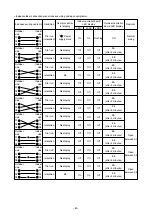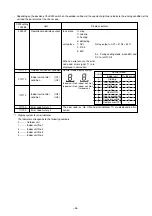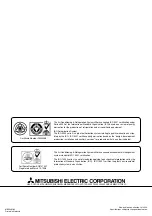
–47–
<Abnormality detected during unit operation: Indoor unit>
Abnormal-
ity display
P8
E4
Meaning of abnormality display and
abnormality troubleshooting
Piping temperature abnormal
<Cool>
When the piping temperature stays
outside the cooling area for 1 minute
after 3 minutes have elapsed since
the compressor was started, the in-
door fan operates at low speed. If the
piping temperature does not return
to the cooling area after 5 minutes
operation at low speed, an abnormal-
ity is recognized.
Note 1) It takes a minimum of 9 min-
utes for an abnormality to be
detected.
Note 2) At dry operation, P8 abnor-
mality is not detected.
<Heat>
When the piping temperature falls
outside the heating area and enters
the ventilation area after compressor
operation and the end of hot adjust,
the indoor fan stops and the piping
temperature does not return to the
heating area within 20 minutes after
10 seconds have elapsed after it left
the heating area, an abnormality is
recognized.
Note 3) It takes a minimum of 22
minutes and a maximum of
27 minutes for an abnormal-
ity to be detected.
Note 4) Except during defrosting
(Detected again after de-
frosting return.)
Remote control communication re-
ceive abnormal
1) When the indoor controller board
can not receive data normally
from the remote controller or an-
other indoor controller board even
once in 3 minutes, an abnormal-
ity is recognized.
2) When the indoor controller board
can not receive signals even once
in 2 minutes, an abnormality is
recognized.
Cause
(1) Indoor intake piping thermistor tem-
perature differential small.
- EInsufficient refrigerant
- EPiping thermistor holder dislodged.
- ERefrigerant circuit faulty.
(2) Extension piping (When multiple units
connected).
(3) Indoor/outdoor connection wire
(When multiple units connected).
(4) Indoor intake piping thermistor detec-
tion faulty.
(1) Remote controller transmission line
contact faulty.
(2) All remote controllers set as “slave”
remote controller.
(3) Remote controller send/receive circuit
faulty.
(4) Indoor controller board send/receive
circuit faulty.
(5) Noise entered on remote controller
transmission line.
Judgment method and remedy
(1) Operate in test run mode and check
piping temperature.
(2)(3)
Check extension piping or indoor/out-
door connection wire.
(4) Check remote controller room tempera-
ture display and piping temperature in
test run mode.
(1) Check if indoor unit or remote control-
ler transmission line disconnected or
loose.
(2) Set one remote controller as “master”.
When there are no problems at the
above
(3) Perform remote controller diagnosis.
a) [RC OK] display
Remote controller normal.
Check by turning power off and on.
If the abnormality occurs again, replace
indoor controller board.
b) [RC NG] display
Replace remote controller.
c) [RC E3] display
[ERC00-66] noise, etc. is probable
cause.

